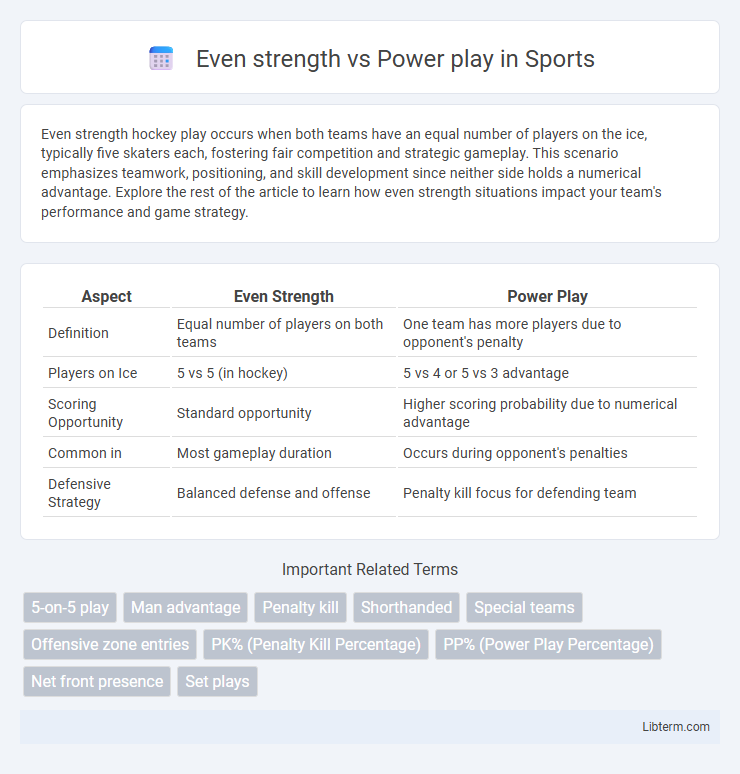Even strength hockey play occurs when both teams have an equal number of players on the ice, typically five skaters each, fostering fair competition and strategic gameplay. This scenario emphasizes teamwork, positioning, and skill development since neither side holds a numerical advantage. Explore the rest of the article to learn how even strength situations impact your team's performance and game strategy.
Table of Comparison
| Aspect | Even Strength | Power Play |
|---|---|---|
| Definition | Equal number of players on both teams | One team has more players due to opponent's penalty |
| Players on Ice | 5 vs 5 (in hockey) | 5 vs 4 or 5 vs 3 advantage |
| Scoring Opportunity | Standard opportunity | Higher scoring probability due to numerical advantage |
| Common in | Most gameplay duration | Occurs during opponent's penalties |
| Defensive Strategy | Balanced defense and offense | Penalty kill focus for defending team |
Understanding Even Strength in Hockey
Even strength in hockey refers to situations where both teams have an equal number of players on the ice, typically five skaters and one goalie each, allowing for balanced competition and true skill assessment. This state contrasts with power play scenarios, where one team has a numerical advantage due to an opponent's penalty, impacting offensive and defensive strategies significantly. Understanding even strength is crucial for analyzing player performance and team dynamics during standard gameplay.
What is a Power Play?
A Power Play occurs in ice hockey when one team has a numerical advantage due to an opponent's penalty, typically resulting in a 5-on-4 player situation. During a Power Play, the advantaged team intensifies offensive pressure to capitalize on the extra skater and increase scoring chances. Effectiveness during Power Plays is measured by power play percentage, highlighting the team's ability to convert opportunities into goals.
Key Differences: Even Strength vs Power Play
Even strength refers to situations in hockey where both teams have an equal number of players on the ice, typically five skaters and one goalie each, emphasizing balanced play and strategic positioning. Power play occurs when one team has a numerical advantage due to an opponent's penalty, creating opportunities for increased offensive pressure and higher scoring chances. The key difference lies in manpower advantage, where even strength demands disciplined defense and equal opportunity, while power play exploits opponent short-handedness to maximize scoring potential.
Strategies Used at Even Strength
Even strength hockey strategies emphasize puck possession, strategic positioning, and effective line changes to maintain offensive pressure while minimizing defensive vulnerabilities. Teams focus on controlling the neutral zone through forechecking and backchecking, utilizing cycling passes and quick puck movement to create scoring opportunities. Strong communication and coordinated defensive coverage are essential to neutralize opponents' attacks during five-on-five play.
Power Play Tactics and Formations
Power play tactics in ice hockey center on maximizing spatial control and puck possession to exploit the numerical advantage against an undermanned penalty kill. Common formations such as the umbrella, overload, and diamond create versatile shooting lanes and passing options, increasing the likelihood of generating high-quality scoring chances. Effective power play units emphasize quick puck movement, strategic positioning, and constant player rotation to disrupt defensive setups and create open shots on goal.
Impact on Game Outcomes: Even Strength vs Power Play
Even strength situations, where both teams have an equal number of players on the ice, significantly influence game outcomes through balanced offensive and defensive opportunities. Power plays create a numerical advantage, increasing the scoring probability and often shifting momentum in favor of the team with the man advantage. Success rates in power plays correlate strongly with overall team performance and can be decisive in close games.
Statistical Insights: Scoring at Even Strength vs Power Play
Scoring rates reveal significant disparities between even strength and power play situations, with NHL teams averaging approximately 2.5 goals per 60 minutes at even strength compared to 6.5 goals per 60 minutes during power plays. Power play efficiency, often measured by a team's conversion percentage, typically ranges between 15% and 25%, highlighting the critical impact of man-advantage scenarios on offensive output. Players with high ice time on power plays can significantly boost their point production, emphasizing the strategic value of specialized units in overall team success.
Penalty Killing: Defending Against the Power Play
Penalty killing is a critical defensive strategy designed to neutralize the opponent's power play advantage when a team is shorthanded due to penalties. Successful penalty killing requires tight positioning, aggressive stick work to disrupt passing lanes, and effective shot blocking to prevent high-danger scoring chances. Teams with high penalty-killing efficiency typically exhibit strong communication and anticipation, forcing turnovers and clearing the puck to regain even strength play.
Coaching Adjustments for Special Teams
Coaching adjustments for special teams prioritize strategic line changes and matchup exploitation during even strength and power play situations. On even strength, coaches focus on maintaining balanced puck possession and minimizing defensive breakdowns through tight zone coverage and quick player rotations. During power plays, coaching emphasizes aggressive puck movement, positioning specialists for optimal shooting lanes, and adaptive formations to counter penalty kill units, maximizing scoring opportunities.
Player Roles in Even Strength and Power Play Situations
Player roles during even strength focus on balanced offensive pressure and defensive coverage, with forwards responsible for creating scoring chances while defensemen maintain puck control and prevent opposing attacks. In power play situations, roles shift to maximize scoring opportunities through strategic puck movement, with the quarterback controlling the play from the point, wings maintaining offensive zone pressure, and the net-front presence screening the goalie and ready for rebounds. Effective execution in these scenarios relies on players' positional awareness, passing accuracy, and quick decision-making tailored to the team's tactical setup.
Even strength Infographic

 libterm.com
libterm.com